Your indoor plants have unique light requirements that you'll need to match carefully for healthy growth. Most houseplants thrive in bright, indirect light, while some need direct sun or can tolerate low light conditions. Watch for signs like leggy growth or scorched leaves to determine if your plants need more or less light. You can use light meters or observe natural sunlight patterns to create the perfect environment for your green collection.
Measuring Available Light in Your Indoor Space
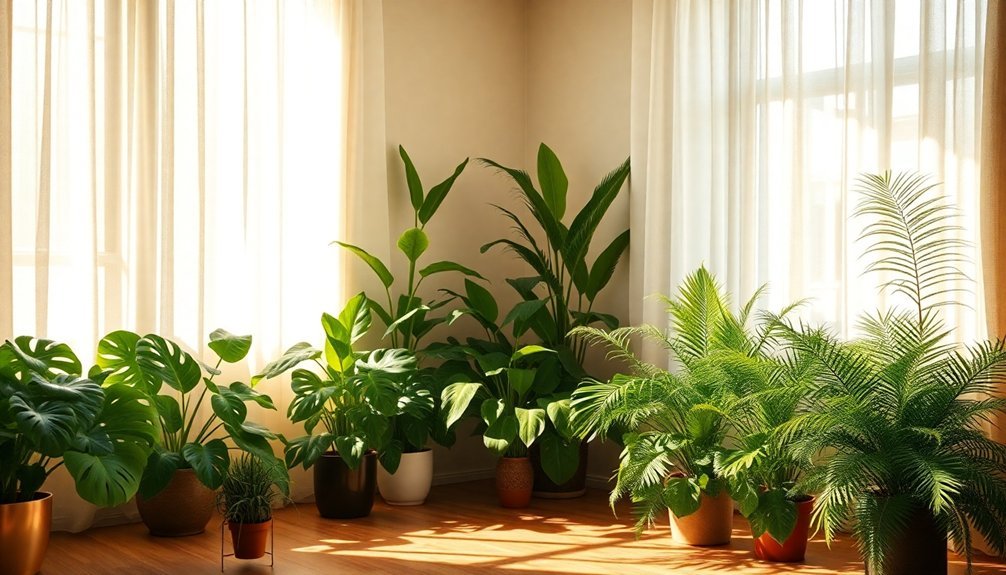
Understanding your indoor light levels is essential before building your green collection. To get accurate measurements, you'll want to evaluate your space during summer when the sun is at its highest point. Track the amount of light throughout the day, noting when direct sunlight hits different areas and for how long.
Pay attention to light intensity variations caused by window orientation, outdoor trees, and seasonal changes. Record each area's exposure and categorize it as full sun, part sun, part shade, or full shade.
This information will help you match plants with their ideal growing conditions based on their labeled requirements. If you find certain spots lack adequate natural light, you can supplement with artificial lighting options like incandescent or fluorescent bulbs to create ideal growing conditions for your plants.
Natural Light Zones and Their Impact
Your indoor and outdoor spaces create distinct light zones that shape how your plants will grow and thrive.
By mapping these zones, you'll discover dramatic differences between interior areas near windows and exterior garden spots that receive varying levels of sunlight throughout the day.
Understanding these light patterns helps you match plants to their ideal locations, whether it's a bright south-facing windowsill or a shaded corner of your garden.
Mapping Your Light Areas
When creating a thriving garden space, mapping your light zones serves as the foundation for successful plant growth. You'll need to track sunlight patterns throughout the day to understand how light moves across your garden.
Start by observing which areas receive direct sunlight and for how long, as different plants require varying amounts of light exposure. Your southern exposures will provide the strongest light source, while northern areas typically remain shadier.
Take note of any obstacles like trees or buildings that affect light distribution. Once you've identified your garden's light patterns, you can match plants' light needs to the appropriate zones.
Consider creating a simple diagram marking full sun (6+ hours), part sun (4-6 hours), and shaded areas (less than 4 hours) to optimize plant placement and guarantee your green collection thrives.
Inside Vs Outside Exposure
The natural light available to plants differs dramatically between indoor and outdoor environments, creating unique challenges for gardeners managing both spaces.
When your plants are exposed to outdoor conditions, they receive unfiltered sunlight with maximum intensity of natural light. Indoor spaces, however, considerably reduce the source of light your plants receive, even near windows.
Key differences between indoor and outdoor light exposure:
- Southern-facing indoor spaces receive the strongest light but still can't match outdoor intensity.
- Indoor plants typically need 14-16 hours of artificial light to equal 6 hours of direct sunlight.
- Window glass filters and reduces light intensity by 50% or more, affecting plant growth.
Understanding these variations helps you adjust care routines and select appropriate plants for each environment, ensuring your green collection thrives regardless of location.
Signs Your Plants Need More Light
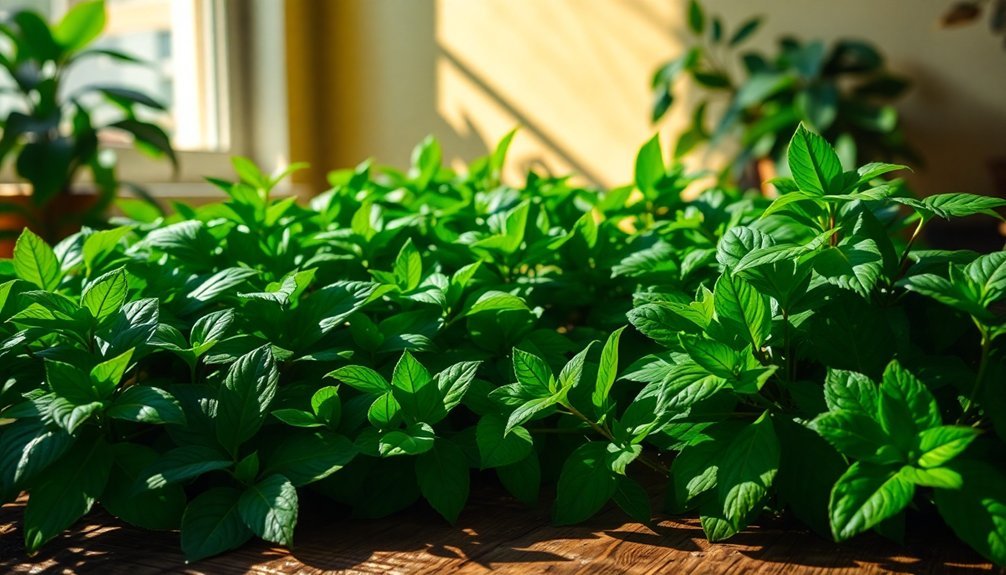
Recognizing early warning signs of insufficient light can save your indoor plants from decline. Your plant growth will show telltale indicators when light levels aren't meeting their needs. Watch for spindly stems with elongated growth and pale green leaves, as these are classic signs of light deficiency.
| Warning Sign | What to Look For | Action Needed |
|---|---|---|
| Leaf Changes | Small, pale, or dropping leaves | Move to brighter spot |
| Growth Pattern | Stretched stems, leaning growth | Adjust light exposure |
| Flowering Issues | Failed blooms, premature drops | Increase light levels |
When you notice leaf color fading or plants growing asymmetrically, it's time to act. While too much direct light can harm some plants, insufficient light prevents proper photosynthesis. Reposition your plants to brighter locations when you spot these symptoms to maintain their health and vibrancy.
Signs Your Plants Are Getting Too Much Light
Your plants will signal light stress through scorched leaf tips and edges, along with faded, washed-out foliage that's lost its natural vibrancy.
If you notice these warning signs, it's time to protect your plants by moving them farther from windows or adding a sheer curtain to filter intense sunlight.
You'll prevent further damage by monitoring your plants daily and adjusting their position until you find the sweet spot where leaves remain healthy and vibrant.
Leaf Burn Warning Signs
Vigilant gardeners know that leaf burn can quickly damage or kill indoor plants when light levels become excessive. When your plants receive too much direct light, they'll display clear warning signs that shouldn't be ignored.
Watch for crispy, brown edges on leaves and fading color as chlorophyll breaks down.
Keep an eye out for these critical indicators:
- Leaves curling or drooping to minimize their exposure to intense light
- Discolored leaves showing spots or patches of burnt tissue
- Bleaching effects where foliage turns pale yellow or washed out
If you notice these symptoms, it's time to take action. Move affected plants to a location with filtered light or add a sheer curtain to diffuse intense sunlight.
Regular monitoring of your plants' response to light will help prevent permanent damage.
Plant Position Solutions
Four telltale signs can alert you to excessive light exposure in your plants.
First, watch for brown, crispy edges on leaves, which indicate scorching from too much light. When your indoor plant's leaves appear washed out or bleached, it's a clear signal to reduce light intensity.
You'll also want to check for curling or distorted leaves, as these are common stress responses to harsh lighting conditions.
If you notice your plants stretching abnormally or growing spindly despite ample light, they're likely trying to escape from too intense exposure.
Additionally, unexplained leaf drop or poor flowering can signal light stress.
To protect your plants, consider moving them further from windows, adding a sheer curtain as a filter, or relocating them to a spot with indirect light.
Artificial Light Solutions for Low-Light Areas
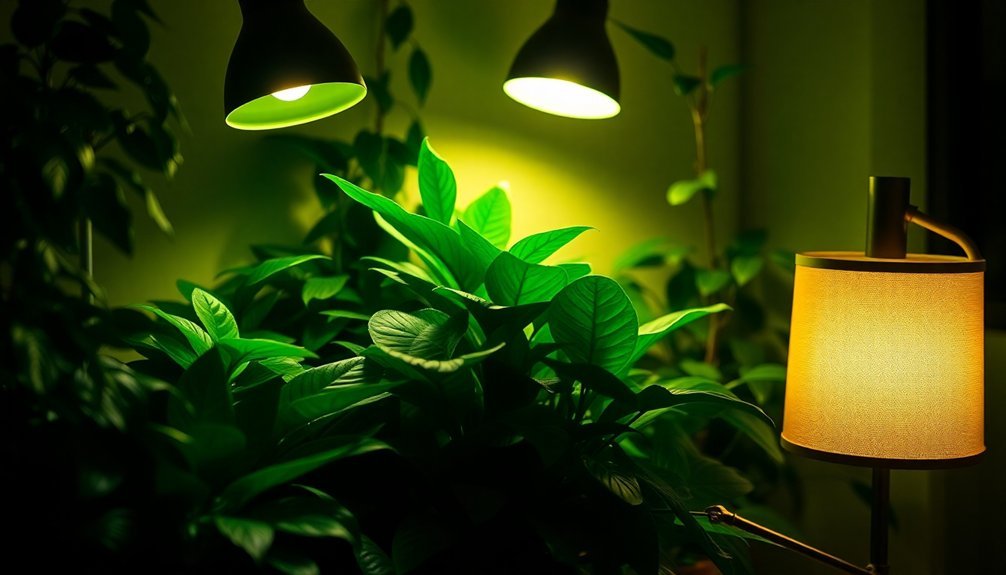
When natural light falls short in your growing space, artificial lighting solutions offer a reliable way to meet your plants' light requirements. Full-spectrum fluorescent bulbs are your best choice, as they closely mimic natural sunlight and provide adequate light exposure for various plant types.
To maximize the benefits of artificial light for your plants:
- Position lights 12-24 inches above your plants to prevent leaf burn while ensuring sufficient intensity.
- Keep lights on for 12-16 hours daily to simulate natural daylight patterns.
- Watch for signs of light stress, including leggy growth or pale leaves, and adjust your setup accordingly.
You'll need to monitor your plants regularly and fine-tune the lighting based on their specific needs, ensuring they receive the right amount of light for healthy growth.
Best Locations for Different Light Requirements
Different plants demand specific light conditions to flourish, making proper placement essential for their success. When positioning your green collection, consider each plant's light exposure needs carefully.
Full sun plants like Soiree Kawaii Vinca need over six hours of direct sunlight, so place them in southern-facing spots. For part shade plants, such as Anthuriums, look for locations that receive gentle morning sun but stay protected from harsh afternoon rays.
You'll want to position Cat Whiskers and similar part-sun varieties where they'll get 4-6 hours of sunlight, either in eastern or western exposures. Shade-loving Calathea thrives in northern-facing areas or under dense canopies.
To guarantee you're choosing the right spots, track sunlight patterns during summer months when light intensity is strongest.
Seasonal Light Changes and Plant Adaptation
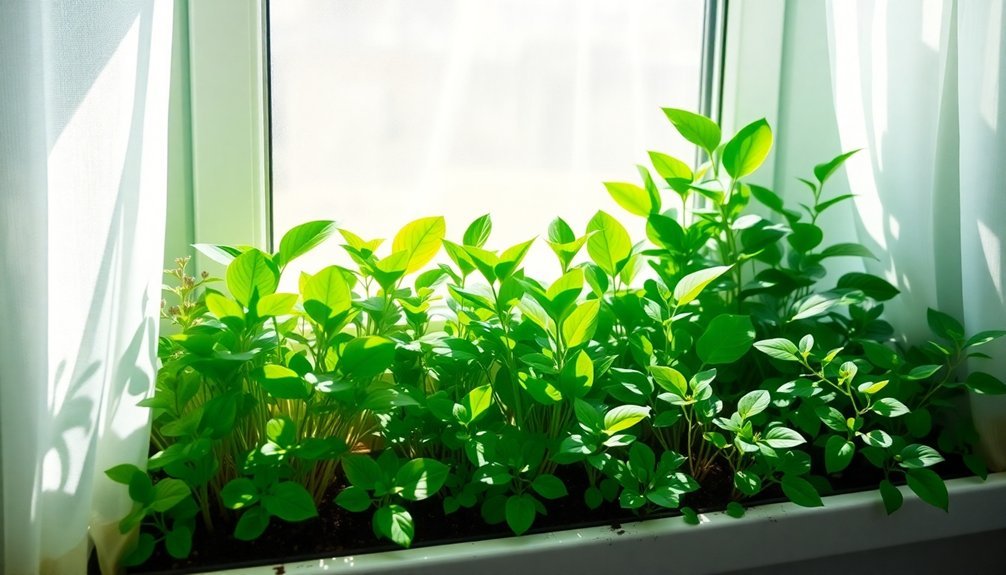
Once you've established ideal locations for your plants, the changing seasons bring new light considerations. Seasonal changes in daylight directly impact your plants' growth and flowering patterns, requiring you to adjust their placement throughout the year.
Your plants naturally adapt to varying light levels through:
Plants are nature's light-seekers, constantly evolving their growth patterns to make the most of available sunlight throughout changing seasons.
- Stem elongation in low-light conditions to reach brighter areas
- Compact growth during high-light periods to optimize photosynthesis
- Altered flowering cycles based on day length exposure
To support healthy plant adaptation, you'll need to monitor and respond to these seasonal shifts. During summer, your plants might thrive in full sun, but you'll want to move them closer to windows in winter to compensate for reduced daylight.
Understanding your region's seasonal light patterns helps you create the ideal environment for your green collection year-round.
Light Meters and Technology Tools
Modern light meters and tech tools take the guesswork out of providing ideal light conditions for your plants.
You'll find various options, from traditional light meters that measure in foot-candles or lux to sophisticated PAR meters that specifically track the light spectrum plants use for photosynthesis.
If you're looking for a convenient solution, your smartphone can help you assess light levels using specialized apps that transform your device's camera into a basic light meter.
These tools let you monitor sun exposure throughout different seasons, ensuring your plants receive optimal lighting year-round.
Whether you choose a professional light meter or a mobile app, tracking light levels will help you make informed decisions about plant placement and care, leading to healthier growth and better adaptation to your home's environment.
Window Direction and Light Quality
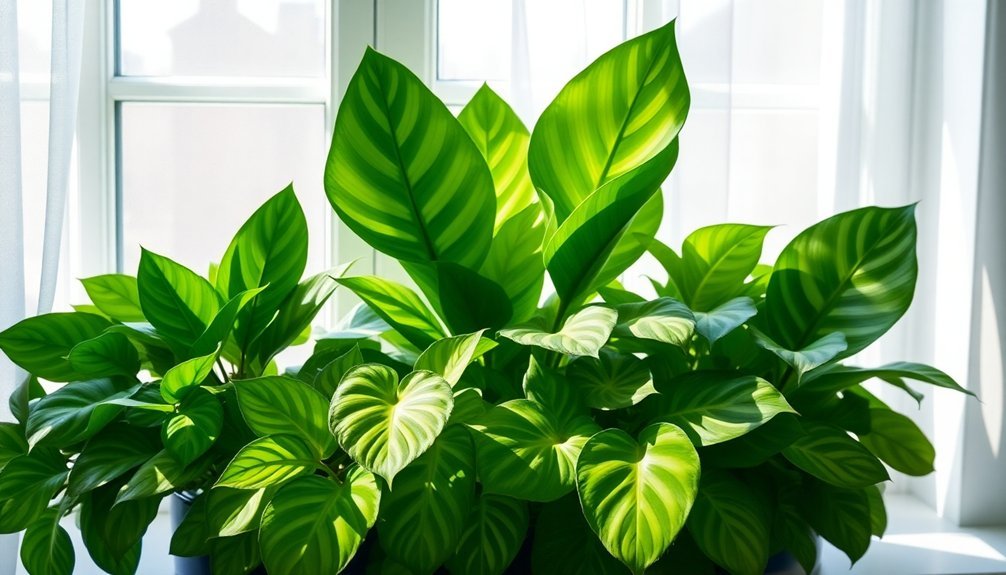
Your window's direction greatly impacts your plants' light exposure, with southern windows delivering intense light for sun-lovers while northern windows offer gentler conditions for shade-tolerant varieties.
You'll find east-facing windows provide balanced morning light that works well for most plants, while west-facing windows can deliver stronger afternoon rays that might require careful plant placement.
Don't forget that your window treatments, such as sheer curtains or blinds, can help you fine-tune the light levels and protect sensitive plants from excessive exposure.
North Vs South Windows
When choosing the ideal location for your indoor plants, understanding the difference between north and south-facing windows is essential for success. The quality of light varies dramatically between these two orientations, affecting your plants' growth and health.
South-facing windows provide the highest light intensity, making them perfect for plants that require mostly direct sunlight. In contrast, north-facing windows offer the least amount of light, ideal for shade-loving species.
Consider these key differences:
- South windows deliver intense, direct light throughout the day, supporting sun-loving plants like succulents and cacti.
- North windows provide consistent, gentle light that's perfect for ferns and peace lilies.
- Plants near south windows may need protection from harsh rays, while those in north windows can sit closer to maximize available light.
East-West Light Patterns
Understanding east and west-facing windows can dramatically improve your plant placement strategy, as these orientations offer distinct light patterns throughout the day.
If you've got east-facing windows, you'll receive gentle morning sunlight that's perfect for plants needing part shade. These windows provide softer illumination that won't scorch sensitive foliage.
West-facing windows deliver stronger afternoon rays, making them ideal for plants that thrive in full sun conditions. However, you'll need to monitor light intensity carefully, as afternoon sun can be quite powerful.
Remember that distance matters – moving your plants closer to or further from the window helps regulate their light exposure. During winter months, you might need to adjust your plants' positions to compensate for reduced light levels and shorter days.
Window Treatments Matter
The strategic placement of window treatments can greatly impact your indoor garden's success, acting as natural light filters for ideal plant growth.
When you're managing light intensity in your plant space, window treatments become essential tools for creating the perfect environment.
Consider these key approaches to optimize your plant lighting:
- Install sheer curtains on southern windows to diffuse intense direct sunlight, protecting sensitive plants from leaf burn while maintaining bright conditions.
- Use adjustable blinds on western windows to control afternoon heat and light exposure, especially during summer months.
- Add reflective surfaces like mirrors or metallic decorative items near northern windows to bounce available light onto your shade-tolerant plants.
You'll find that thoughtful window treatment choices help you maintain ideal growing conditions throughout the seasons, ensuring your plants thrive year-round.
Balancing Light Duration and Intensity
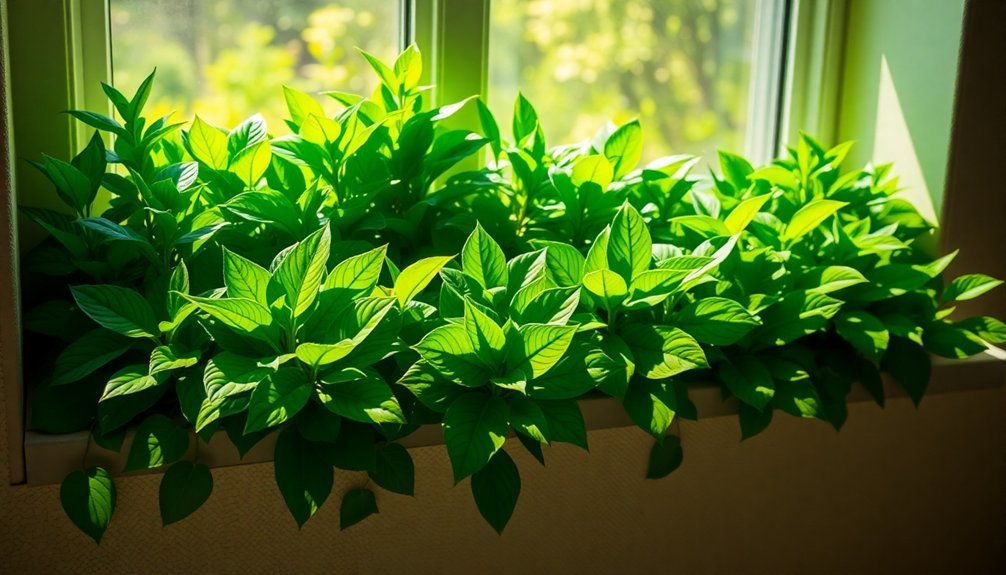
Successful indoor gardening hinges on finding the sweet spot between light duration and intensity for your plants. You'll need to monitor both factors carefully, as too much light exposure can damage leaves, while insufficient light leads to weak growth. For ideal results, limit light duration to 16 hours daily and maintain temperatures between 70-80°F during the day.
| Light Factor | Impact on Plants |
|---|---|
| High Intensity | Compact, dark green leaves |
| Low Intensity | Spindly growth, pale foliage |
| Long Duration | Potential leaf burn |
| Short Duration | Reduced growth rate |
| Proper Balance | Healthy flowering plants |
When natural light isn't enough, you can supplement with artificial lighting. Remember that flowering plants have specific light duration requirements, falling into short-day, long-day, or day-neutral categories. Adjust your lighting schedule accordingly to promote healthy blooming.
Plant Rotation and Light Management Strategies
Because ideal plant growth depends on consistent light exposure, implementing a strategic rotation schedule is crucial for your indoor garden.
You'll need to monitor sun patterns throughout the day and adjust your plants' positions accordingly. Consider using reflective surfaces like light-colored walls to maximize available light for sun-loving specimens.
To maintain optimal light exposure through plant rotation:
- Keep a log of sunlight patterns in different areas of your space
- Rotate plants 1/4 turn weekly to prevent leaning and guarantee even growth
- Move plants seasonally, placing them closer to windows during winter months
Don't forget to supplement natural light with grow lights when needed, especially during shorter days.
This thorough approach to light management will help your plants thrive year-round, regardless of their specific light requirements.
Frequently Asked Questions
What Are the Color Codes for Garbage Bins?
You'll find black/gray bins for general waste, blue for recyclables, green for organic materials, red for hazardous waste, and brown for yard waste. However, check your local guidelines as colors may vary by location.
What Are the 4 Classification of Garbage?
You'll need to know the four main types of garbage: organic waste for your food scraps, recyclable materials for paper and plastics, hazardous waste for chemicals and batteries, and general waste for non-recyclables.
What Is the Difference Between Green and Blue Waste?
Your green waste includes compostable materials like grass clippings and food scraps, while your blue waste consists of recyclable items like plastics and metals. They're processed differently – green through composting, blue through recycling facilities.
Can Green Waste Be Recycled?
Yes, you can definitely recycle your green waste! You've got several options: use curbside collection programs, take it to recycling facilities, or start composting at home. It's an eco-friendly way to handle organic materials.
In Summary
You'll find success in your indoor garden by regularly monitoring light conditions and adjusting as needed. Keep track of how your plants respond, rotate them periodically, and don't hesitate to supplement with artificial lighting when natural light falls short. Remember, every plant's light needs are unique – it's worth taking time to understand each species' requirements for a thriving green collection.

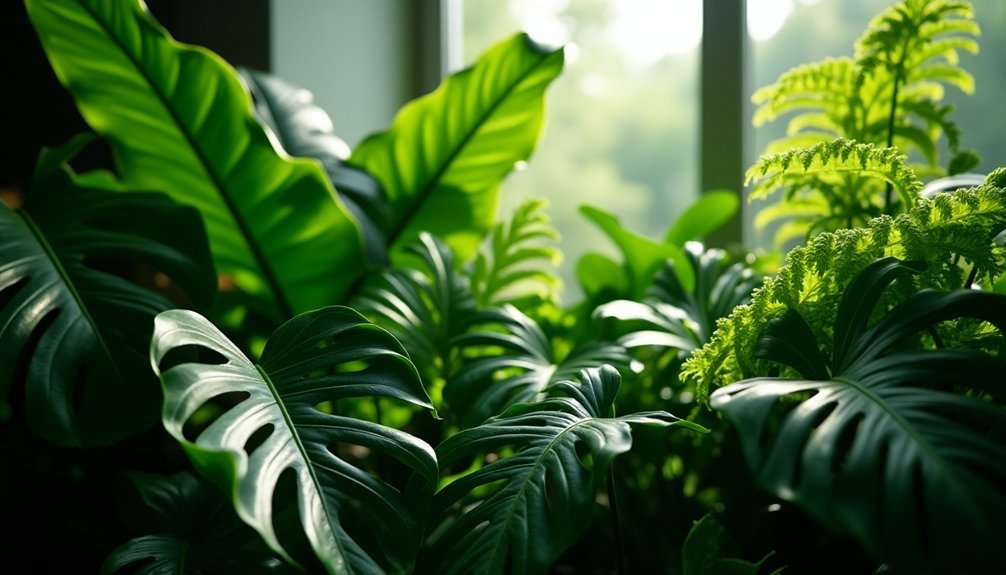



Leave a Reply